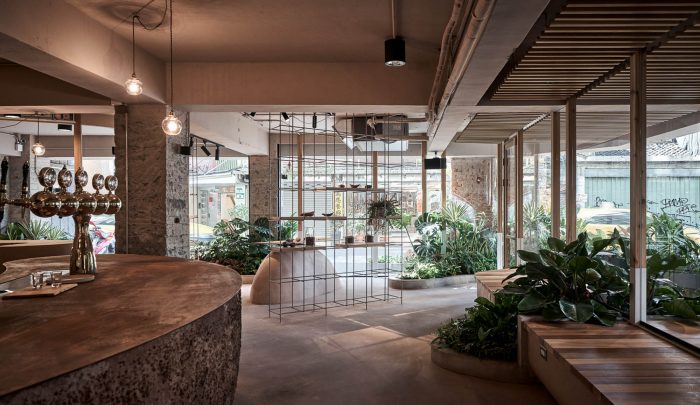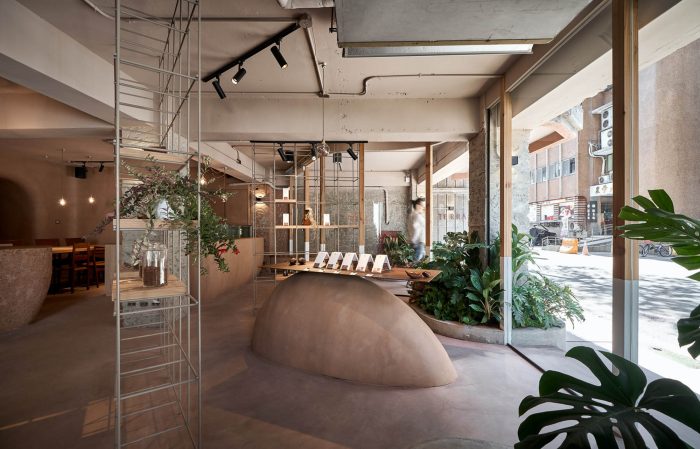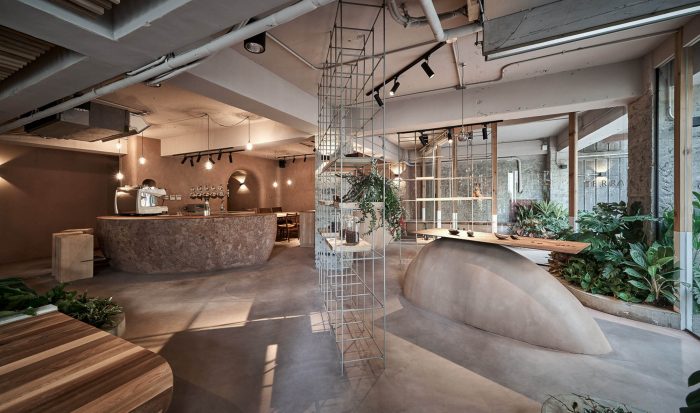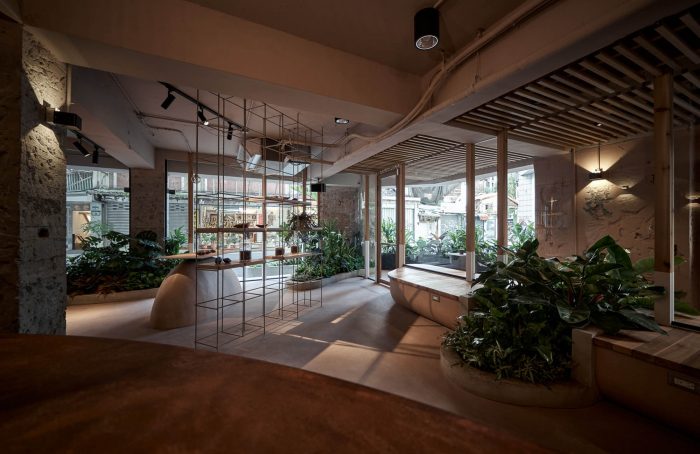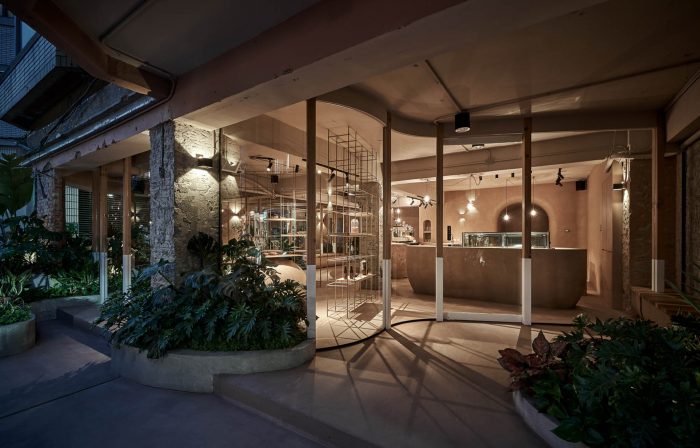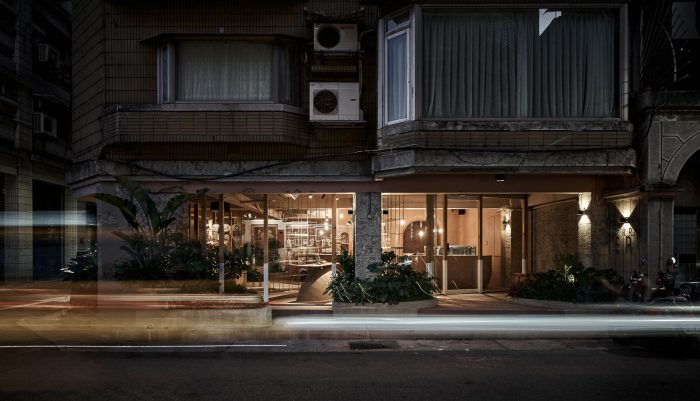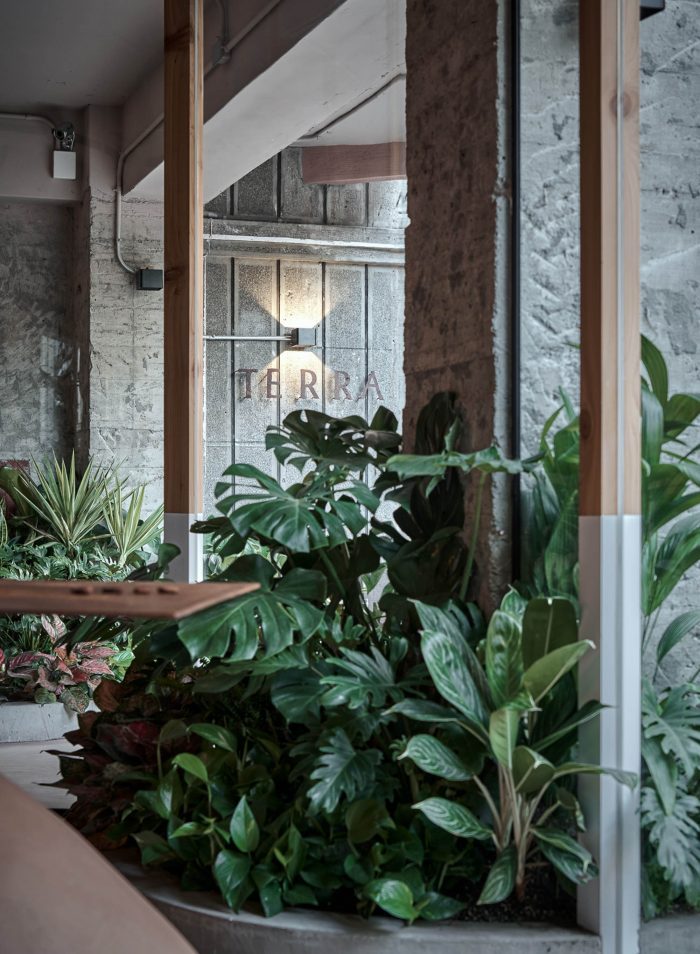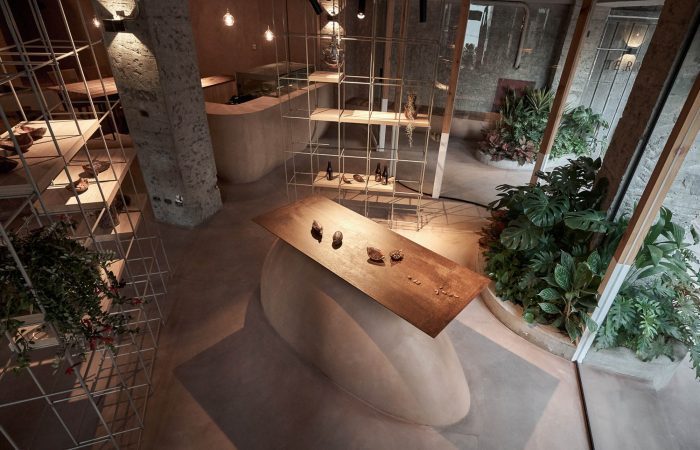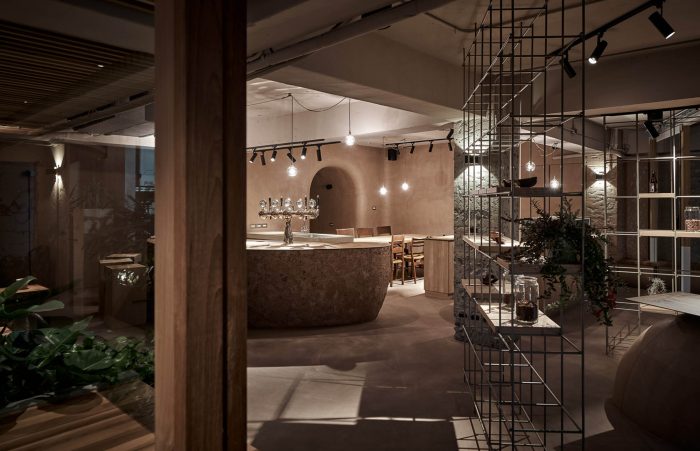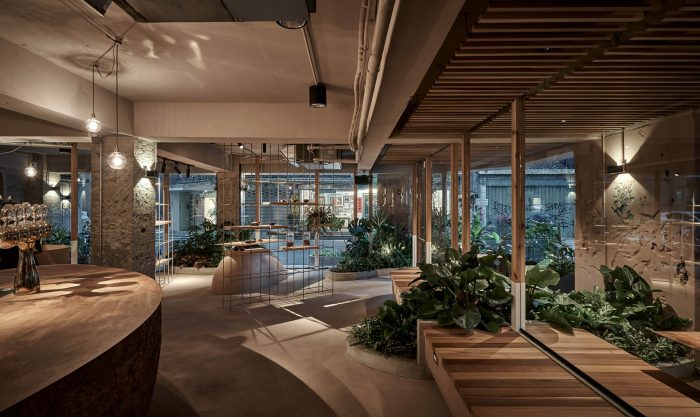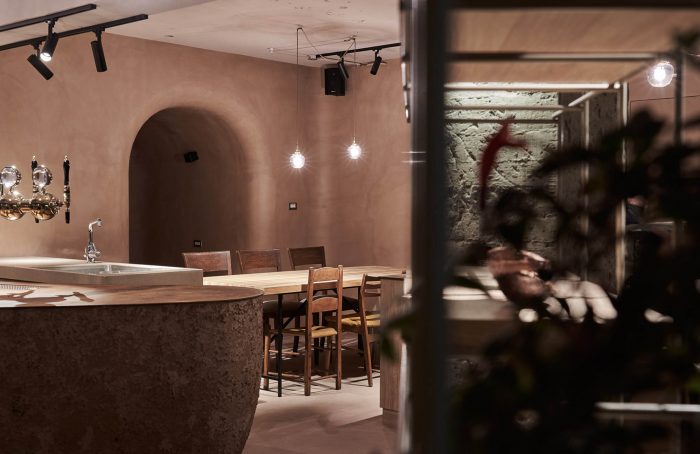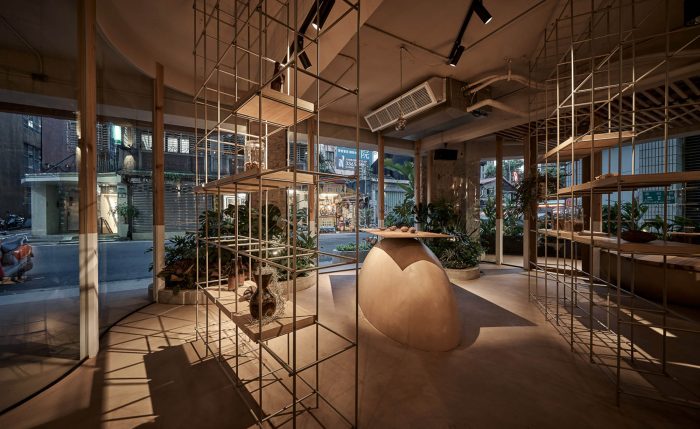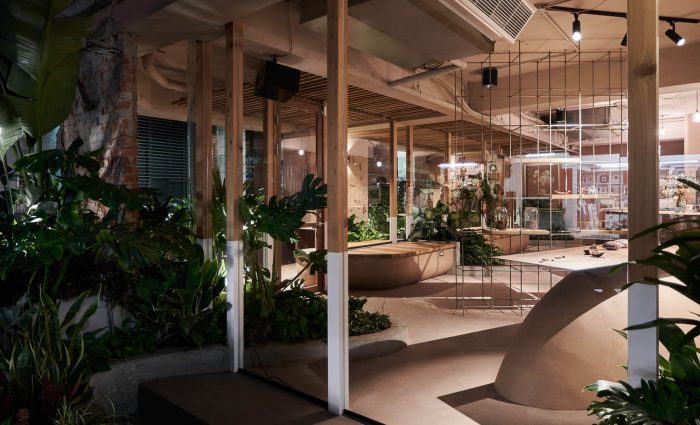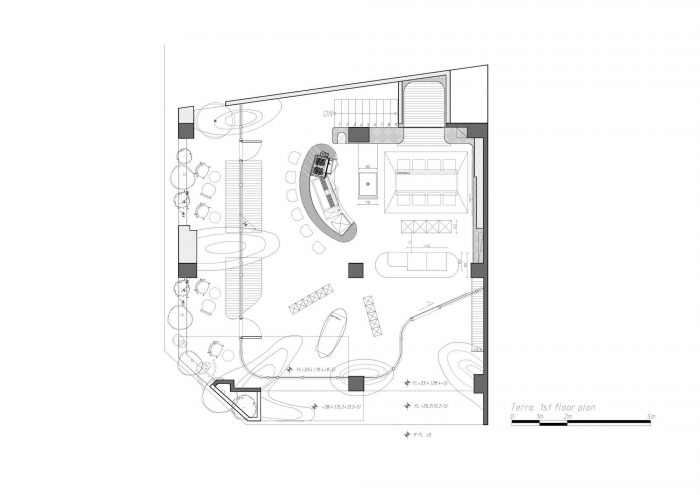Terra是一家巧克力专卖店。厨师在世界各地寻找各种可可豆,从南美、印度到亚洲和其他地方。”从豆子到酒吧 “是该品牌的宗旨,让顾客一开始就能品尝到可可最原始的味道,并享受其衍生的甜点和饮料或巧克力酒等产品。拆解和探索巧克力甜品和饮料的本质,其实就是 “体验自然”。我们把可可豆这种大自然的果实变成各种食物。不同国家和地区生产的果实口味不同,反映了气候和土壤、阳光等自然因素的差异。此外,在与业主的访谈中,业主反映了他在中南美洲农业技术教学组的经历和在森林中生活的经历。这些都诱发了我们希望这个房间的设计能够更加 “自然”。
Terra is a chocolate specialty store. The chef travels around the world to search for all kinds of cocoa beans, from South America, India to Asia and other places. “From bean to bar” is the brand’s purpose, allowing customers to taste the most original flavor of cocoa at the beginning, and to enjoy its derivative desserts and drinks or chocolate liquor and other products. Dismantling and exploring the essence of chocolate desserts and drinks is actually “experiencing nature”. We turn cocoa beans, the fruit of nature, into various foods. The taste of the fruits produced in different countries and regions vary, reflecting the difference in climate and soil, sunshine and other natural factors. In addition, in the interview with the owner, the owner reflected his experience in the agricultural technology teaching group in Central and South America and living in the forest. These all induced our hope that the design of this room can be more “natural”.
我们以 “自然侵入室内 “和 “雨林中的BAR “为主要概念,开始设计这栋位于老社区一角的30年历史的公寓楼的首层,结合各种自然特征和元素来呈现整体空间。
We started designing the first floor of this 30-year-old apartment building at the corner of the old community with the main concepts of “nature invading the indoors” and “BAR in the rainforest”, combining various natural characteristics and elements to present the overall space.
首先,我们将原有的室内区域下凹1.5至2米,堆砌土堆,种植植物,并采用软设计手法,在老公寓的底层营造出一个花园般的空间。我们打算重塑角落空间的形象,对社区更加友好。通过增加更多的绿化和景观,甚至把前院的入口留给社区居民驻足休息,这让新品牌通过诱人的形象和空间风格与社区融为一体,使商业空间具有更温暖的社区感和地域性。(让商业空间更加融入当地社区)
First, we recessed the original indoor area by 1.5 to 2 meters, piled up mounds, planted plants, and used soft design techniques to create a garden-like space on the ground floor of the old apartment. We intend to reshape the image of the corner space and be friendlier to the community. By adding more greenery and landscape, and even leaving the front yard entry for community residents to stop and rest, this allows the new brand to commingle with the community through an inviting image and spatial style, giving the commercial space a much warmer sense of community and locality. (Let the commercial space be more integrated into the local community)
上面提到的凹陷空间在这里变成了户外餐饮区,用植物和土堆作为边界,让使用者体验到被自然包围的感觉,但又不过分分割整体空间,只是让人感觉到置身于自然之中。这个空间似乎有边界,但它们又相互连接。这样一来,光线和风可以很容易地通过周围缩进的走廊进入基地。阳光通过树枝和气流在空间中自由流动,创造了一个更舒适的基地小气候,让用户被植物包围,享受用餐时间。
The above-mentioned recess space becomes an outdoor dining area here, using plants and mounds as boundaries, allowing users to experience the feeling of being surrounded by nature, but not excessively dividing the overall space, just the feeling of being in nature. The space seems to have boundaries, but they are connected to each other. In this way, light and wind can easily enter the base through the retracted surrounding corridors. The sunlight flows freely in the space through branches and airflow, creating a more comfortable base microclimate and allowing users to be surrounded by plants and enjoy meal time.
自然侵入室内 “的主题贯穿整个场地。我们让室外的植物和土墩延伸到室内,”自然蔓延 “的设计手法使室内气氛更加自然,模糊了室内外的界限。这延伸了视觉感,为室内使用者创造了 “植物和自然从外面蔓延到室内 “和 “被自然包围 “的感觉。通过放射性的平面设计手法,将种植土堆、展示架等都引向室内吧台,也可以理解为以吧台为中心进行分流。这种设计手法使室内使用者的视觉感向外延伸,产生视觉上的流动性,放大了空间体验,使心情更加自由;而对于室外人员来说,则形成了单点消除般的视觉吸引效果,增加了路人的好奇心。我们特意将动线做成自然环境中的 “雨林 “小路一样的曲折,整个方案被视为几条循环动线的组合。空间中的非线性行走路径使人们无法直接感受到空间的范围。步行体验更加自然有趣,也使空间更加流畅。
The theme of “Nature Invading the Indoors” runs through the entire venue. We let the outdoor plants and mounds extend into the interior, and the “Natural Spread” design technique makes the indoor atmosphere more natural and blurs the boundary between indoor and outdoor. This extends the sense of vision and creates the feeling of “plants and nature spreading from the outside to the inside” and “being surrounded by nature” for indoor users. Through radioactive graphic design techniques, the planting mounds, display racks, etc. are all directed to the indoor bar, which can also be understood as diverging from the bar as the center. This design technique allows the visual sense of the indoor users to extend outward, resulting in visual fluidity, magnifying the space experience and making the mood more free; while for the outdoor personnel, it creates a visual attraction effect like a single point of elimination, increasing the curiosity of passersby. We deliberately made the moving lines as twists and turns like the “rainforest” path in the natural environment, and the whole scheme is regarded as a combination of several circulating moving lines. The nonlinear walking path in the space makes people unable to directly feel the extent of the space. The walking experience is more natural and interesting, and it also makes the space more fluid.
透明材料(玻璃)被用作外墙,以加强内部和外部之间的联系和边界的模糊的设计意图。实木框架和透明展示架象征着自然森林的视觉感,弧形玻璃外墙体现了空间的流动性。室内的整体色彩规划来源于 “土壤”,呼应了天然水果的主题,并使用可可豆果实来设计展示架、蛋糕柜和酒吧柜台。吧台也是用可可豆的磨碎的果实和外壳作为颜料,我们邀请厨师和我们一起手工绘制,创造了更多的自然纹理,坚持了自然主题。
The transparent material (glass) is used as the exterior wall to strengthen the design intent of the connection between the interior and the exterior and the blurring boundary. The solid wood frames and the transparent display shelf symbolize the visual sense of the natural forest, and the curved glass exterior wall reflects the fluidity of the space. The overall color plan of the interior is derived from “soil”, echoing the theme of natural fruits, and used cocoa bean fruit to design display stands, cake cabinets and bar counters. The bar counter is also made using the ground fruits and shells of cocoa beans as paint, which we invited the chef to paint with us by hand, creating more natural texture and adhering to the natural theme.
延伸 “从豆子到酒吧 “的品牌概念,我们用 “从自然到空间 “来开发各种设计手法,从营造友好的社区空间,整体的自然氛围,到更好的基地小气候,希望给空间和社区带来更多的可能性。
Extending the concept of the brand “Bean to bar”, we used “from nature to space” to develop a variety of design techniques, from creating a friendly community space, an overall natural atmosphere, to a better base micro-climate, hoping to bring more possibilities to the space and the community.
建筑师:Soar Design Studio
面积:120 m²
年份:2021年
照片: Hey! Cheese
制造商:Topciment
首席建筑师:Ray Chang
细节设计:Jiaxun Wu
城市:台北市
国家:中国
Architects: Soar Design Studio
Area: 120 m²
Year: 2021
Photographs: Hey! Cheese
Manufacturers: Topciment
Lead Architects: Ray Chang
Detail Design:Jiaxun Wu
City:Taipei City
Country:China






